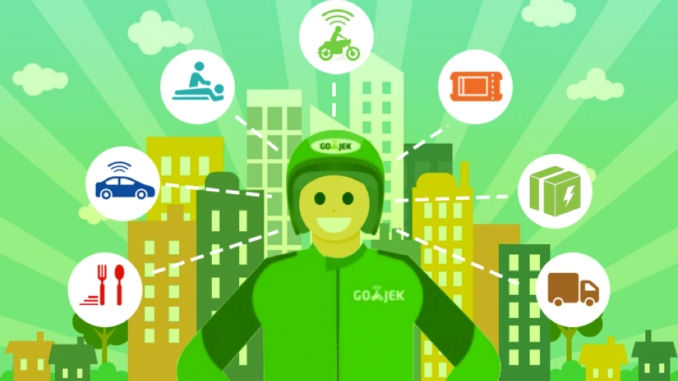
Indonesia is a country with over 275 million people living in it. Today, in big cities such as Jakarta, Surabaya, Makassar, Malang, and even small towns and regions, there are a swarming of an ocean of green within the streets. In action are Gojek’s drivers, wearing their signature green helmets and jackets, roaming around the streets and stopping by the side of the road to pick up orders, do tasks such as getting food or shop from the local convenience store, before delivering them to the end-user — the customer (Ford & Honan, 2017).
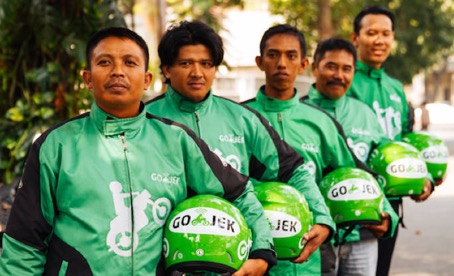
While the Indonesian homegrown platform which is the nation’s first decacorn has provided a substantial positive impact to the society with just below 30 million users in Indonesia, it is considered a disruptive innovation within the sharing economy. This essay will therefore evaluate and provide a critical account on Gojek as a company; bringing into light both its internal and external partners, investors as well as the company’s investments to strengthen its core in Indonesia’s on-demand market, and analysing the decacorn’s direct and indirect competitors. Moreover, it will also look at the regulatory body that controls Gojek and helps moderate it within the Indonesian market.
About the Super App
Gojek is an application that works on Android and iOS phones that focuses on providing a multitude of services, mainly using motorcycle taxis or ojek as its chosen mode of transportation. The on-demand service platform allows its users to hail a motorcycle taxi (hereinafter, ojek), or use the ojek to deliver food, shop for daily necessities, or send packages. Through the Gojek super app, users can book a Gojek to do anything for them.
Services
The platform divides its subsidiary services into four categories:
- Transport and Logistics: GoRide, GoCar, GoBlueBird, GoSend, GoBox
- Food and Fast-Moving-Consumer-Goods (FMCG): GoFood, GoMed, GoMart
- Payments: GoPay, GoTagihan, GoSure, GoInvestasi
- News and Entertainment: GoPlay, GoTix

Gojek was founded by Nadiem Makarim in 2010. An individual who found himself resorting to motorcycle taxis to avoid Jakarta’s notorious traffic conditions (Ford & Honan, 2017), the platform started simply as an ojek hailing call centre in Indonesia in 2010, which then introduced three services in 2015: GoRide, GoSend and GoMart in 2015. Now, it provides over 20 services with the company currently valued at $12.5 billion as of 2020. The company is also one of the leaders for Indonesia’s digital wallet GoPay which permits customers and drivers to pay digitally.
The company answered the problem to Indonesia’s lack of infrastructure for public transport and chronic traffic congestion, in which the app provides a hassle-free and cheaper fixed-rate measured through distance covered from pick-up point to destination compared to the conventional ojek (Azzuhri et al., 2018). Moreover, the service also provided a solution for those living in precarious employment and poverty willing to become micro-entrepreneurs as Gojek drivers (2018). Gojek drivers who commonly used to be conventional ojek drivers or worked in other informal sector jobs made the switch to Gojek as they saw the potential for higher incomes, more reliable access to customers, and insurance (Ford & Honan, 2017).
Gojek’s mobile ojek-hailing feature essentially created a previously notably vacant market with its competitors being only conventional ojek drivers (Lee, 2018). While so, it also competes with public buses as well as taxis as one’s preferred mode of transportation.

Major competitors to Gojek included multinational compan Uber, whom after 4 years of operating in Indonesia was acquisitioned by Malaysian company Grab. Today, Grab and GOjek are head-to-head in the on-demand ojek service market, though Gojek still has the upper hand over geographic scope and services variation (Ford & Honan, 2017).
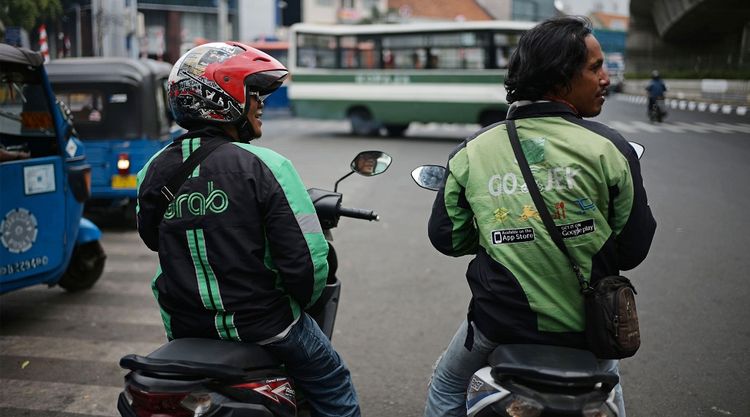
Meanwhile, the company’s food delivery service GoFood already had several restaurant-based incumbents such as McDonald’s McDelivery, Pizza Hut’s PHD, and Domino’s. However, GoFood has an advantage as users can freely choose which restaurants they want to order from. During its early years, even if a restaurant has not partnered with GoFood, users can opt to use GoShop — the precedent service to GoMart, to specifically choose the restaurant and the items they would like to purchase. Today, there are 125,000 restaurants in Indonesia that have partnered with the app.
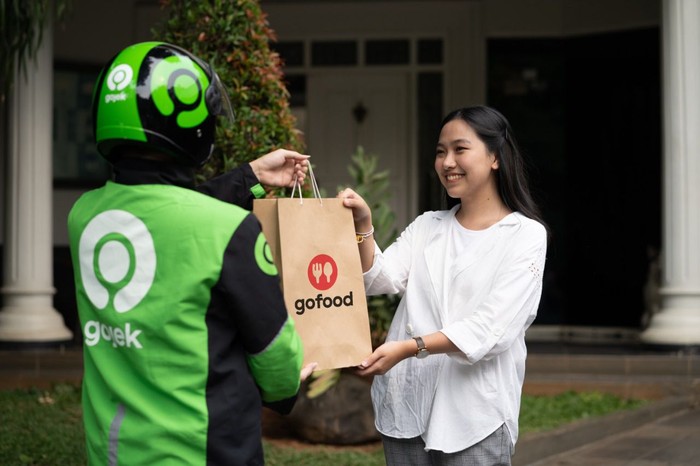
An interview with Gojek drivers shows that the employment opportunities offered by the company are imperative to increase in income; flexible working hours also seems to be an attractive point for both men and women to become Gojek drivers, whom the company refers to as their ‘partners’ rather than employees (Ford & Honan, 2017).
Disruptive Innovation vs. Regulatory Challenges
Clayton Christensen coined the term ‘disruptive innovation’, substantially highlighting the fact that in a given market, new products or services can exploit basic applications from the bottom of the market and eventually displaces established competitors or incumbents. This is applicable to the case of Gojek, who came in 10th in CNBC’s Disruptor 50 in 2020.
Gojek’s service offering is considered disruptive because it capitalizes on an existing mode of transportation — the conventional ojek, and whose platform links a previously nonexistent linkage between customers and drivers (Suseno, 2018). Strong resistance therefore exists from traditional ojek drivers who have questioned and pressured authorities to assess the legality of online transportation companies i.e Gojek, Uber and Grab.
In Indonesia, advancements in technology are combined efforts done by both the state and private entities (Lee, 2018). One of the challenges in information technology systems research is understanding how a new technology is accepted (adopted) or rejected by society (Al-hujran, 1998, as cited in Suzianti et al., 2018). Despite the perceived significant positive reaction towards Gojek as a super app in the current Indonesian on-demand lifestyle market, there have been several issues that Suzianti et al. (2018) has outlined while using the application:
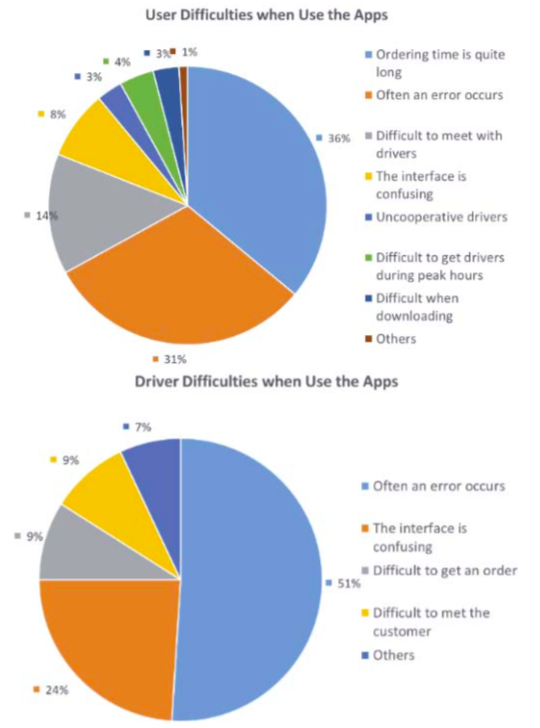
A study by Chandra & Wirapraja (2020) on GoFood customers shows that a significant proportion of customers expect excellent care, communication, as well as service guarantee i.e security during transaction. Despite the tangible elements in Gojek’s services (for example, the provision of drivers’ photographs, vehicle plate numbers, and the green jacket uniform), the fact that Gojek is an online service reinforces that the company must ensure consistency and security to be delivered in their service.
Debate on regulation also has revolved around online transport services’ failure to comply with public transport licensing — since they do not pay for taxes as a public transport company nor pay for such licenses for the drivers, they acquire cost advantage and are able to offer cheaper prices to customers (Ford & Honan, 2017). This has resulted in riots conducted by conventional Blue Bird taxi drivers rejecting app-based ride-hailing services, deemed as ‘illegal transportation’. In March 2019, statutory law has been established around the operations of online ojek (Malawani et al., 2020).
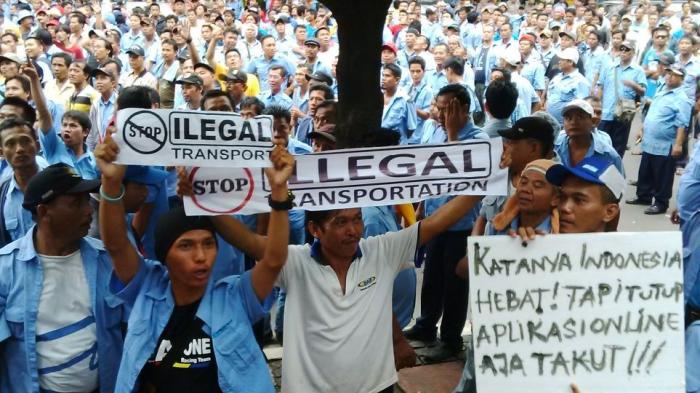
Earlier in February, Gojek had acquired shares of Blue Bird taxi company amounting to 4.33%, justifying its GoBlueBird feature which allows users to book taxicabs throughout the country despite the rivalries between the two companies. Gojek has been able to gain further advantage over the fact that their primary focus is on motorcycle taxis, who are not regulated in the country, rather than taxicabs (Ford & Honan, 2017). While so, earlier in December 2015, the Ministry of Transportation announced a ban on all online transport services on the basis that these forms of transports do not meet the 3-wheeled, legal approval nor public transportation permits requirement. This was then answered with a public outcry to #savegojek which became national top-trend on Twitter upon the announcement of the ban.
#SaveGojek, In this digitalized era, the gov't should be thankful for their existence as it reduces unemployment and traffic jam!
— Nadhila Renaldi (@dheanadhila) December 18, 2015
Sharing economy platform
In a research conducted by Constantiou et al. (2017), there exists four models of sharing economy platforms; Franchiser, Principal, Chaperone and Gardener. Each model is classified through two dimensions, namely the level of control imposed towards platform participants by its owners, and the intensity of rivalry among platform participants (2017, p. 232).
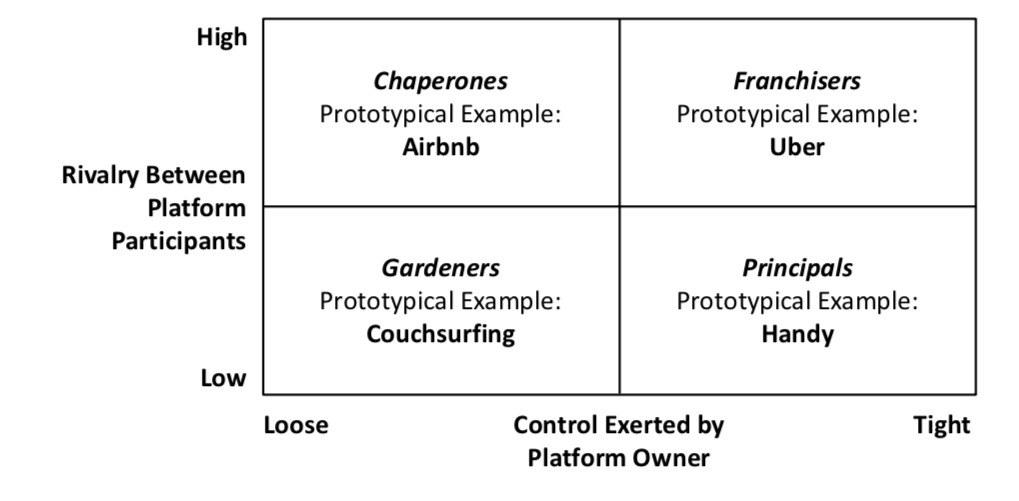
Through the 4 models of sharing economy platform above, Saputra (2019) has categorised Gojek’s services to the following:

Skeptically, Malawani et al. (2020) argues that Gojek’s sharing economy system as a platform is overshadowed by technological facilitarion within its commercial exchanges — this permits the usage of “platform capitalism” as a preferred term to describe Gojek’s phenomenon, as the platform’s economy lives through monetary injections from venture capitalists by exploiting socially produced wealth.
In late 2019, the company had raised over US$1 billion through investors such as Google, JD.com, Tencent, Mitsubishi, and others — these were all done as an effort to strengthen its foundation in the Indonesian market as well as its expansion to South East Asian countries namely Singapore, Thailand and Vietnam. Facebook and PayPal has also been reported to have invested in the company. Gojek also partnered with Google as its’ GPS service provider as well as for the company’s cloud platform for its data and servers.
The ecosystem of Gojek as a company is outlined below:

In today’s society, a significant proportion of Indonesia’s population relies on Gojek, both customers and drivers. The service offering that Gojek provides which varies from not only provision of an alternative to Indonesia’s still growing public transportation but also the conduct of daily tasks such as food and FMCG delivery services. Usage of technology is now bound to our daily lives (Monteiro, 2018, as cited in Gumilar et al., 2019), as is the case of Gojek’s users.
An infographic on the way Gojek is embedded in the Indonesian market is shown below:
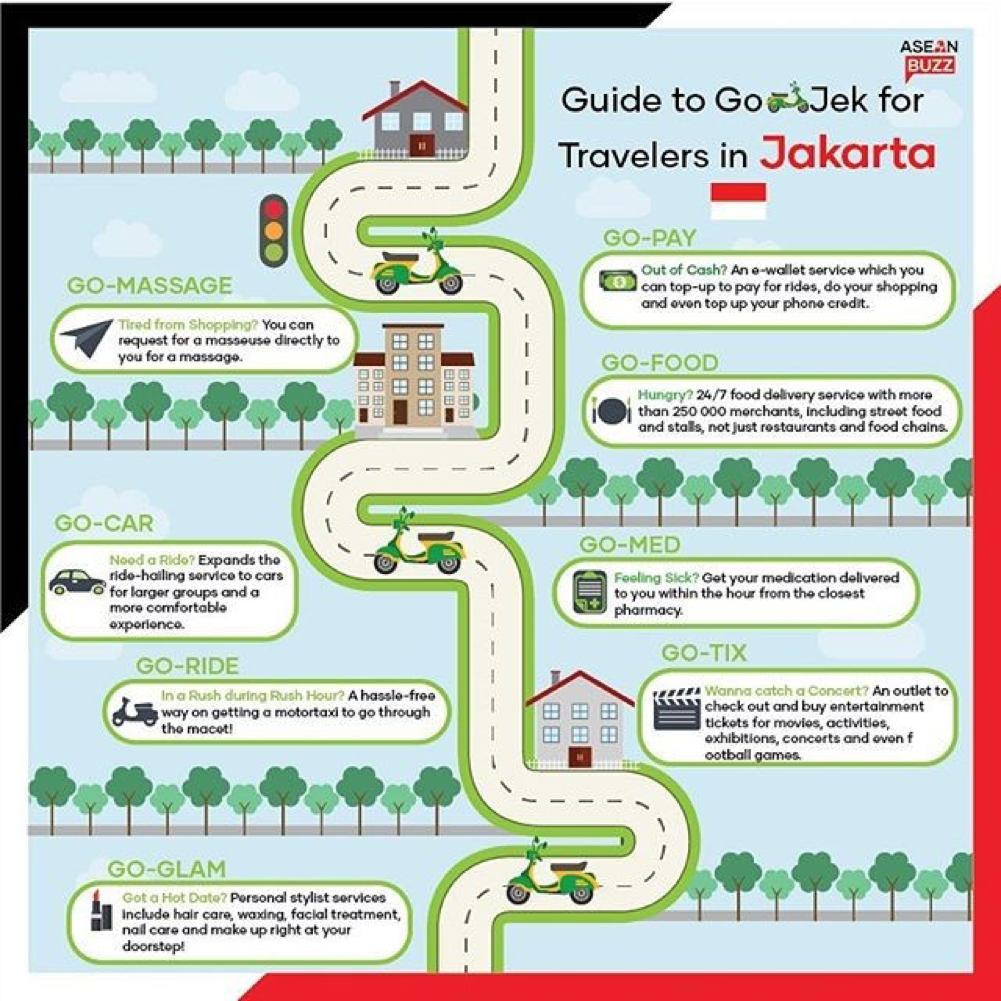
Concluding words
Gojek has revolutionised the conventional motorcycle taxis, known in Indonesia as ojek, as it capitalised on Indonesia’s relatively cheap labour by combining technologies within the traditional mode of transportation. The platform has opened new employment opportunities for those who worked in informal job sectors, ensuring security and an opportunity to become micro-entrepreneurs in control of their own income. Despite the initial difficulties in placing the platform’s service offering within the Indonesian economy, the company is now regulated and moderated by several government bodies and community groups. Additionally, the Gojek phenomenon has opened up new opportunities for other small business owners to use the platform to speed up the supply chain system and delivery processes. Whatever it is, there is always an ojek for every need.
Reference List
Azzuhri, A., Syarafina, A., Yoga, F. T., Amalia, R. (2018). A Creative, Innovative, and Solutive Transportation for Indonesia with Its Setbacks and How to Tackle Them: A Case Study of the Phenomenal GOJEK. Review of Integrative Business and Economics Research, 7(1), 59-67. Retrieved from http://ezproxy.library.usyd.edu.au/login?url=https://www-proquest-com.ezproxy1.library.usyd.edu.au/docview/1969778160?accountid=14757
Chandra, W. & Wirapraja, A. (2020). The Effect of Application Usability, Service Quality, and E-Satisfaction on Purchase Intention of GoFood Customers. Indonesian Journal of Information Systems, 3(1), pp. 38-49. Retrieved from https://ojs.uajy.ac.id/index.php/IJIS/article/view/3563/1899
Christensen, C. Disruptive Innovation. Key Concepts. Retrieved from https://claytonchristensen.com/key-concepts/
Constantiou, I. D., Marton, A., & Tuunainen, V. P. (2017). Four Models of Sharing Economy Platforms, MIS Quarterly Executive, 16(4), pp. 231-251. Retrieved from https://www.researchgate.net/publication/321576374_Four_Models_of_Sharing_Economy_Platforms
Ford, M. & Honan, V. (2017). The Go-Jek Effect. In E. Jurriens & R. Tapsell (Eds.), Digital Indonesia: Connectivity and Divergence (pp. 275-299). Singapore: ISEAS – Yusof Ishak Institute. Retrieved from https://ses.library.usyd.edu.au/bitstream/handle/2123/21325/Postprint_GoJek%20Effect.pdf?sequence=2
Gumilar, A., Dionisius, W. D., Oliver, I., Gunawan, J., Sfenrianto, S. (2019). Factors Affecting the Actual Use of Ride-Hailing Services (Gojek/Grab) in Indonesia (Jabodetabek Region), Proceedings on Engineering Sciences, 1(2), pp. 335-348. DOI: https://doi.org/10.24874/PES01.02.030
Lee, D. (2018). How Ojek Became Go-Jek: Disruptive Technologies and the Infrastructure of Urban Citizenship in Indonesia. International Journal of Urban and Regional Research. Retrieved from https://www.ijurr.org/spotlight-on/disruptive-urban-technologies/how-ojek-became-go-jek-disruptive-technologies-and-the-infrastructure-of-urban-citizenship-in-indonesia/
Malawani A.D., Salahudin S., Qodir Z., Loilatu M.J., Nurmandi A. (2020) The Evolution of “GOJEK” as an Indonesian Urban Mobile Ride Hailing Model Study Case: Public and Government Regulatory Responses on Urban Mobile Ride Hailing. In Stephanidis C., Antona M. (Eds.) HCI International 2020 – Posters. HCII 2020. Communications in Computer and Information Science, vol 1226. Springer, Cham. DOI: https://doi.org/10.1007/978-3-030-50732-9_56
Saputra, P. R. (2019). Model of the Sharing Economy Platform in Indonesia, Case Study: Gojek. Universitas Islam Raden Rahmat, Indonesia. Retrieved from https://ipief.umy.ac.id/wp-content/uploads/2019/08/Model-of-Economy-Platform-in-Indonesia.pdf
Suzianti, A., Herawati, R. & Septiandi, Y. (2018). Analysis of Affecting Technology Adoption Factors in Online Transportation Reservation for Smartphone Application. Case Study: PT. Gojek Indonesia. ICCIP ’18: Proceedings of the 4th International Conference on Communication and Information Processing, pp. 198-203. DOI: https://doi-org.ezproxy2.library.usyd.edu.au/10.1145/3290420.3290435
Hypertextual Articles
10. Gojek. (2020, June). CNBC Disruptor 50. Retrieved from https://www.cnbc.com/2020/06/16/gojek-disruptor-50.html
About GoFood: What is GoFood? (n.d.). GoFood Partners’ Resources Center. Retrieved from https://www.gojek.com/gofood/partner-center/faq/gofood/about-gofood/#what-is-gofood
Budiari, I., Batu, S. F., Anya, A. (2016, March). Taxi drivers riot over lack of regulations. The Jakarta Post. Retrieved from https://www.thejakartapost.com/news/2016/03/23/taxi-drivers-riot-over-lack-regulations.html
Choudhury, S. R. (2020, June). Facebook, PayPal invest in Indonesia’s ride-hailing firm Gojek. CNBC. Retrieved from https://www.cnbc.com/2020/06/03/facebook-invests-in-indonesia-gojek.html
Dahrul F. & suhartono, H. (2020, February). Gojek Buys $30 Million Stake in Taxi Operator Blue Bird. Bloomberg. Retrieved from https://www.bloomberg.com/news/articles/2020-02-17/gojek-said-to-complete-stake-purchase-in-taxi-operator-blue-bird
GO-JEK: Using Machine Learning for forecasting and dynamic pricing. (n.d.). Google Cloud Platform. Retrieved from https://cloud.google.com/customers/go-jek
Press Centre: Statement from Grab Indonesia on Grab Acquisition of Uber Southeast Asia. (2018, March). Grab. Retrieved from https://www.grab.com/id/en/press/business/pernyataan-grab-indonesia-terkait-akusisi-grab-terhadap-uber-di-asia-tenggara/
History. (2020). Gojek. Retrieved from http://gojek.com/about
Indonesia Population 2020. Worldometer. Retrieved from https://www.worldometers.info/world-population/indonesia-population/
Lu, T. (2018, January). Sharing Economy in Indonesia with a case Study on Go-Jek Mobile App. Quotes Writer. Retrieved from https://mugn.medium.com/sharing-economy-in-indonesia-with-a-case-study-on-go-jek-mobile-app-5136a63bf38c
Our Services. (2020). Gojek. Retrieved from http://gojek.com
Saiidi, U. (2017, April). A ride on Indonesia’s first and only ‘unicorn’. CNBC. Retrieved from https://www.cnbc.com/2017/04/24/a-ride-on-indonesias-first-and-only-unicorn.html
Pillai, S. (2019, February). Gojek raises over US$1 billion as ride-hailing giants beef up their portfolios. The Business Times. Retrieved from https://www.businesstimes.com.sg/garage/news/gojek-raises-over-us1-billion-as-ride-hailing-giants-beef-up-their-portfolios
Statista. (2019). Number of monthly active users (MAU) of Gojek in Southeast Asia as of November 2019, by country. Retrieved from https://www.statista.com/statistics/1168407/sea-number-of-gojek-monthly-active-users/
Transportation ministry bans Go-jek and other app-based transport services, outraged netizens start #savegojek. (2015, December). Coconuts Jakarta. Retrieved from https://coconuts.co/jakarta/news/transportation-ministry-bans-go-jek-and-other-app-based-transport-services-outraged/
Venkatraman, A. (2017). We Are Banking on Our Digital Wallet Go-Pay for the Foreseeable Future – Go-Jek CTO, Ajey Gore. Inc42. Retrieved from https://inc42.com/buzz/go-jek-go-pay-digital-wallet-indonesia/
What is a Gojek? (2016, January). Demystify Asia. Retrieved from http://www.demystifyasia.com/what-is-a-gojek/
Multimedia
AseanBuzz. (2019, February 1). Gojek Tour, Jakarta [Infographic]. Retrieved from https://aseanbuzz.wixsite.com/aseanbuzz/post/gojek-tour-jakarta
Constantiou, I. D., Marton, A., Tuunainen, V. P. (2017). Four Models of Sharing Economy Platforms [Figure], MIS Quarterly Executive, 16(4), pp. 231-251. Retrieved from https://www.researchgate.net/publication/321576374_Four_Models_of_Sharing_Economy_Platforms
DetikInet. (2019, November 6). Gojek Punya Fitur Baru, Pesanan GoFood Jadi Lebih Ngebut [Image]. Retrieved from https://inet.detik.com/cyberlife/d-4774361/gojek-punya-fitur-baru-pesanan-gofood-jadi-lebih-ngebut
DheaNadila. (2015, December 18). #SaveGojek, In this digitalized era, the gov’t should be thankful for their existence as it reduces unemployment and traffic jam! [Twitter post]. Retrieved from https://twitter.com/dheanadhila/status/677679695547224064
Felisiani, T. (2016, March 23). Sopir Blue Bird Terkena Tembakan Orang Misterius Saat Aksi Unjuk Rasa [Image]. Retrieved from https://m.tribunnews.com/metropolitan/2016/03/23/sopir-blue-bird-terkena-tembakan-orang-misterius-saat-aksi-unjuk-rasa
GadgetSquad. (2019, January 31). Gojek vs Grab, Mana yang Paling Banyak Dipakai Pengguna? [Image]. Retrieved from https://gadgetsquad.id/versus/gojek-vs-grab/
Gojek. (2018, November 10). Pahlawan di Balik Keseharian Kita [Image]. Retrieved from https://www.gojek.com/blog/gojek/pahlawan-dibalik-keseharianmu/
Google Play Store. (n.d.). Google [Image]. Retrieved from https://play.google.com/store/apps/details?id=com.gojek.app&hl=en&gl=US
Illustration by Gojek. (2019, January 3). Lontar.id [Illustration] Retrieved from https://lontar.id/gojek-yang-tak-sekadar-aplikasi-driver/
Suzianti, A., Herawati, R. & Septiandi, Y. (2018). Analysis of Affecting Technology Adoption Factors in Online Transportation Reservation for Smartphone Application. Case Study: PT. Gojek Indonesia [Figure]. ICCIP ’18: Proceedings of the 4th International Conference on Communication and Information Processing, pp. 198-203. DOI: https://doi-org.ezproxy2.library.usyd.edu.au/10.1145/3290420.3290435
Utomo, T. W. (2015, October 1). Gojek vs Ojek Kuning UI dalam bingkai fotografi [Image]. Retrieved from https://twutomo.wordpress.com/2015/10/01/gojek-ojek-ui-dalam-bingkai-fotografi/
